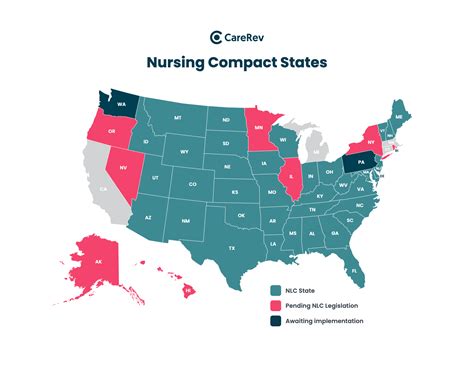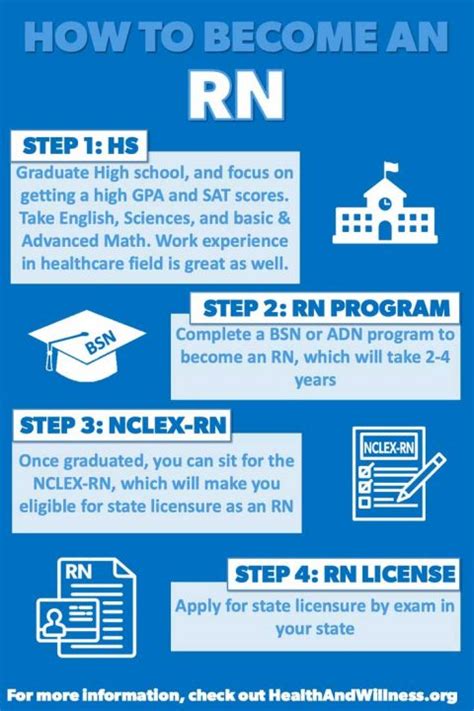Intro
Embark on a rewarding nursing career with our comprehensive guide on how to become an RN. Discover the step-by-step process, from meeting educational requirements to obtaining licensure and certifications. Learn about RN roles, salary expectations, and job growth prospects, and get expert tips on advancing your career in this in-demand field.
Nursing is a rewarding and challenging profession that offers a wide range of career opportunities. As a registered nurse (RN), you will have the chance to make a real difference in people's lives, working with patients, families, and communities to promote health and well-being. If you are considering a career in nursing, this article will provide you with a step-by-step guide on how to become an RN.

Step 1: Meet the Basic Requirements
To become an RN, you must meet the basic requirements set by the state in which you wish to practice. These requirements typically include:
- Earning a high school diploma or equivalent
- Completing a nursing program approved by the state
- Passing the National Council Licensure Examination (NCLEX-RN)
- Obtaining a state license to practice as an RN
Education and Training
There are several types of nursing programs available, including:
- Associate's degree in nursing (ADN)
- Bachelor's degree in nursing (BSN)
- Diploma in nursing
- Licensed practical nurse (LPN) or licensed vocational nurse (LVN) programs
While an ADN or diploma in nursing may be sufficient to become an RN, a BSN is often preferred by employers and may provide more career advancement opportunities.
Step 2: Choose a Nursing Program
When choosing a nursing program, consider the following factors:
- Accreditation: Look for programs accredited by the Commission on Collegiate Nursing Education (CCNE) or the Accreditation Commission for Education in Nursing (ACEN)
- Program length: ADN programs typically take two years to complete, while BSN programs take four years
- Curriculum: Ensure the program includes both classroom and clinical instruction in areas such as anatomy, physiology, and pharmacology
- Cost: Consider the total cost of the program, including tuition, fees, and living expenses

Types of Nursing Programs
There are several types of nursing programs available, including:
- Traditional nursing programs: Offered on-campus, these programs provide a traditional nursing education
- Online nursing programs: Offered online, these programs provide flexibility and convenience
- Accelerated nursing programs: Designed for individuals with a non-nursing degree, these programs provide an accelerated path to becoming an RN
- RN-to-BSN programs: Designed for RNs with an ADN or diploma, these programs provide a path to earning a BSN
Step 3: Complete Clinical Experience
Clinical experience is an essential part of nursing education. During clinical rotations, you will work directly with patients, applying the skills and knowledge you have learned in the classroom.
Clinical Experience
Clinical experience may include:
- Working in hospitals, clinics, or other healthcare facilities
- Participating in simulation labs and other hands-on training experiences
- Caring for patients in a variety of settings, including medical-surgical, pediatrics, and critical care

Step 4: Pass the NCLEX-RN Exam
After completing your nursing program, you will be eligible to take the NCLEX-RN exam. This exam is required for licensure as an RN in the United States.
NCLEX-RN Exam
The NCLEX-RN exam is a comprehensive, multiple-choice exam that tests your knowledge and skills in areas such as:
- Safe and effective care environment
- Health promotion and maintenance
- Psychological integrity
- Physiological integrity
Step 5: Obtain State Licensure
After passing the NCLEX-RN exam, you will be eligible to apply for state licensure as an RN. Requirements for licensure vary by state, but typically include:
- Submitting an application and paying a fee
- Providing transcripts and other documentation
- Passing a background check

Step 6: Pursue Certification (Optional)
Certification is not required to practice as an RN, but it can demonstrate expertise and commitment to your profession.
Certification Options
There are several certification options available for RNs, including:
- Certified Medical-Surgical Registered Nurse (CMSRN)
- Certified Critical Care Registered Nurse (CCRN)
- Certified Pediatric Nurse (CPN)
Step 7: Maintain Licensure and Certification
To maintain licensure and certification, RNs must complete continuing education requirements and adhere to state and national standards.
Continuing Education
Continuing education requirements vary by state, but typically include:
- Completing a certain number of hours of continuing education courses
- Participating in professional development activities
- Maintaining certification

Conclusion
Becoming an RN requires dedication, hard work, and a passion for helping others. By following these steps, you can begin your journey to a rewarding career in nursing.

FAQs
What is the difference between an ADN and a BSN?
+An ADN (Associate's Degree in Nursing) typically takes two years to complete, while a BSN (Bachelor's Degree in Nursing) takes four years. A BSN is often preferred by employers and may provide more career advancement opportunities.
How do I choose a nursing program?
+Consider factors such as accreditation, program length, curriculum, and cost. Look for programs accredited by the Commission on Collegiate Nursing Education (CCNE) or the Accreditation Commission for Education in Nursing (ACEN).
What is the NCLEX-RN exam?
+The NCLEX-RN exam is a comprehensive, multiple-choice exam that tests your knowledge and skills in areas such as safe and effective care environment, health promotion and maintenance, psychological integrity, and physiological integrity.
